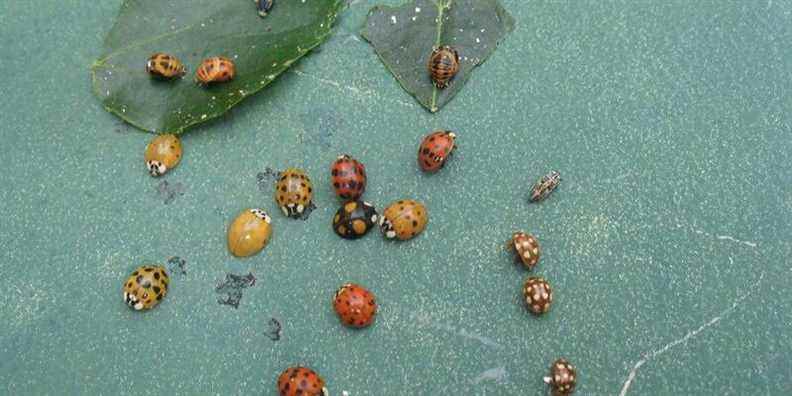A little true/false about ladybugs:
§ The number of points indicates the age of the animal?
Falseladybugs are beetles, insects with complete metamorphosis, when the adult (imago) comes out of its cocoon it has its final shape and its color becomes final after a few minutes.
§ Large ladybugs are the oldest
False, the adult “hatches” with its final size. In the same species there can be differences in size, they are mainly due to the quantity of food of the larvae.
§ Ladybugs eat aphids?
True and falseladybugs often have a specific diet even if some can fall back on other sources in case of scarcity.
Some like the seven-spotted ladybug do not eat bean or broad bean aphids because they are poisonous to them.
§ Asian ladybugs eliminate European ones?
False, These ladybugs are very voracious, sometimes the larvae feed on other ladybug larvae, but cannibalism is common among ladybugs. This is also why ladybugs do not lay eggs near other ladybug larvae.
§ Are the larvae the most voracious?
True, The larvae are the most voracious. The adults also eat insects but they also feed on pollen, nectar or honeydew.
§ Ladybugs eat each other?
Truebut it is the larvae that eat each other or eat eggs when food is lacking.
§ Ladybugs only eat insects?
False, it depends on the species. There are aphidiphagous ladybugs, others that eat certain types of mealybugs (depending on the species), mites. Some species are rather polyphagous like Propylea 14punctata which also attack psyllids or leafhoppers.
There are also lady beetles that feed on fungal spores or even on plants such as the bryony beetle which can attack melon plants.
Their diets
Plants, fungi, aphids, scale insects, thrips, mites. Each has its particularities, as much by the biotope in which they live as by its prey.
The biotopes
Each biotope has its ladybugs, trees, herbaceous layer, wasteland, brambles… There is practically at least one species of ladybug per type of environment.
– Jacques Ginet
how to have it in your garden?
Ladybugs happily move over average distances of a few tens of meters to a few hundred depending on the needs.
Honeydew particularly attracts them to trees and plants because it is a likely sign of the presence of biting insects, aphids or psyllids.
But they often also need pollen which is an interesting source of protein to produce their eggs. The flowers attract them as well as the plant diversity which guarantees several sources of food spread over time.
By trade or in nature
Some species of ladybirds, commonly used in culture, are bred by laboratories and sold commercially, this is the case for Adalia bipunctata, Rodolia cardinalis, Chilocorus nigritus. Others are easy to find in nature and you can take a few larvae to import them into your garden provided you do not plunder a site.
Some portraits of interesting species present in Isère:
· Harmonia axyridis, the Asian lady beetle which has had a bad press because of imports of a very aggressive strain in the past but which coexists well with other species.

– Jacques Ginet
· Hippodamia variegata, the wasteland ladybug. Small elongated ladybugs easily recognizable by the design of its pronotum (above the thorax). It lives mainly in the herbaceous stratum and is fond of apiaceae aphids. Quite common on fennel flowers.

– Jacques Ginet
· Chilocorus renipustulatus, small round black ladybug with 2 orange spots characterized, like its close species of which it is very similar, by a rim along the elytra.

– Jacques Ginet
· Exochomus quadripustulatus, Black Ladybug with 4 red dots, 2 of which have a comma shape. Indigenous predator of mealy bugs.

– Jacques Ginet
· Propylea quatordecempunctata, Checkered Ladybug, characterized by the angular shape of the spots on its elytra. Generally yellow with black spots, but the reverse also exists. Very polyphagous, it is interesting to fight against the albizzia psylla: Acizzia jamatonica.
· Oenopia conglobata pink ladybug with black spots. Easily identifiable by a Z-shaped line connecting two spots. Aphidophagous

– Jacques Ginet
· Adalia bipunctata, tree beetle. Small, two-pointed, red with black points or sometimes the reverse. One of the most marketed ladybugs very effective against aphids in the herbaceous layer.
· Platynaspis luteorubra, Ladybug of brambles. Small black ladybug with red spots, a little hairy. The larva is very recognizable (see photo).

– Jacques Ginet
· Scymnus sp, small, slightly hairy black ladybug with or without red dots depending on the species. Its larva is very recognizable as it resembles mealybugs, but the shape of its waxy shield is a bit different in shape from mealybugs.

– Jacques Ginet
· Rhyzobius, a tiny ladybug that preys on mites. Native, but difficult to see due to its small size.
· Rodolia cardinalis, Australian lady beetle black with red spots. This ladybug is somewhat at the origin of integrated biological protection (IBP) since it was introduced in France at the beginning of the 20th century to fight against the Australian citrus mealybug: Icerya purchasi. Acclimatized on the Mediterranean rim and the South of France because it remains chilly. Can survive mild winters in the Grenoble region. Traded species.

– Jacques Ginet
Ask all your questions during the gardening program on Sunday morning on France bleu Isère from 9 a.m. to 10 a.m. by calling 04 76 46 45 45.
